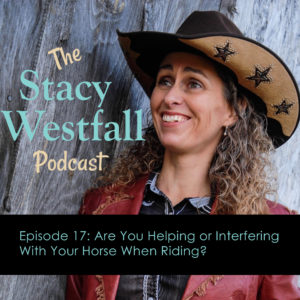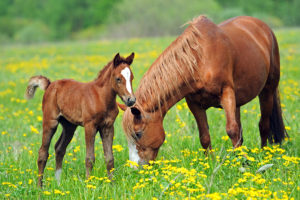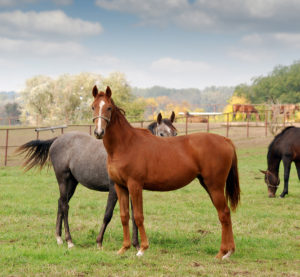Episode 17: Are You Helping or Interfering With Your Horse When Riding?

Today, I’m talking about active and passive riding. Do you know if you are doing too much or not enough when riding? A rider who doesn’t know how to ride may be in a defensive position and not doing enough. A rider using all available aids may be doing too much and making the horse unhappy.
In this episode, I talk about these concepts and finding the neutral middle ground using active tension. I also talk about finding your seat and independent movement from the horse.
“Having a purpose and a plan in the arena made me an active rider.” Stacy Westfall Click To TweetSubscribe and never miss an episode! (I listen in the barn and when I’m out driving)
Subscribe For Free!
Show Notes
[01:07] Imagine a teeter totter with too much on one side and not enough on the other. The middle is the neutral position or a non-disturbing connection.
[01:34] Connection is hidden inside the active and passive rider conversation.

[02:13] When it comes to connection, we can also be doing too much or not enough.
[02:47] A rider who doesn’t know how to ride will not be doing enough.
[03:31] Another extreme would be a rider doing too much and using all of the aids all of the time, so the horse does not feel a release.
[04:06] A sign of this could be the horse looking very unhappy.
[04:51] The reason I want you to think about how active or passive you are when riding is because you have to have a version of positive tension to get to the neutral position.

[06:40] When doing riding exercises, we need to be able to return to a neutral state.
[09:39] A full release doesn’t have to be that we take away all of the aids from the horse because then we would take away all of their support and communication.
[09:56] If we end up too far on the other side of the teeter-totter, we interfere with the horse.
[10:25] In a free walk, a horse is supposed to be marching forward. You really have to pay attention to your aid to ride this maneuver.
[11:55] You have to go back and forth between active and neutral and adjust the pressure in your legs and put the intention in your body.

[12:49] My mom and I used to ride bareback trail riding. When I started using my western saddle, it would make my knees hurt. I blamed it on the saddle, but then I realized this was because I was collapsing on the horse and moving to the passenger side. Riding bareback requires tension.
[14:52] I retrained my body to be more active when I’m trail riding which will intuitively be better for my horses.
[15:23] One of the first things you need to find when you are riding is an independent seat. Try carrying a glass of water or an egg in a spoon and see if you can ride with your hands staying independent of the movement of the horse.
Links and Resources:
How Clear Intention Leads to Clear Aids and Prompt Results
SUBSCRIBE TO THE PODCAST HERE:





YOURS FREE
WHY IS MY HORSE...?




